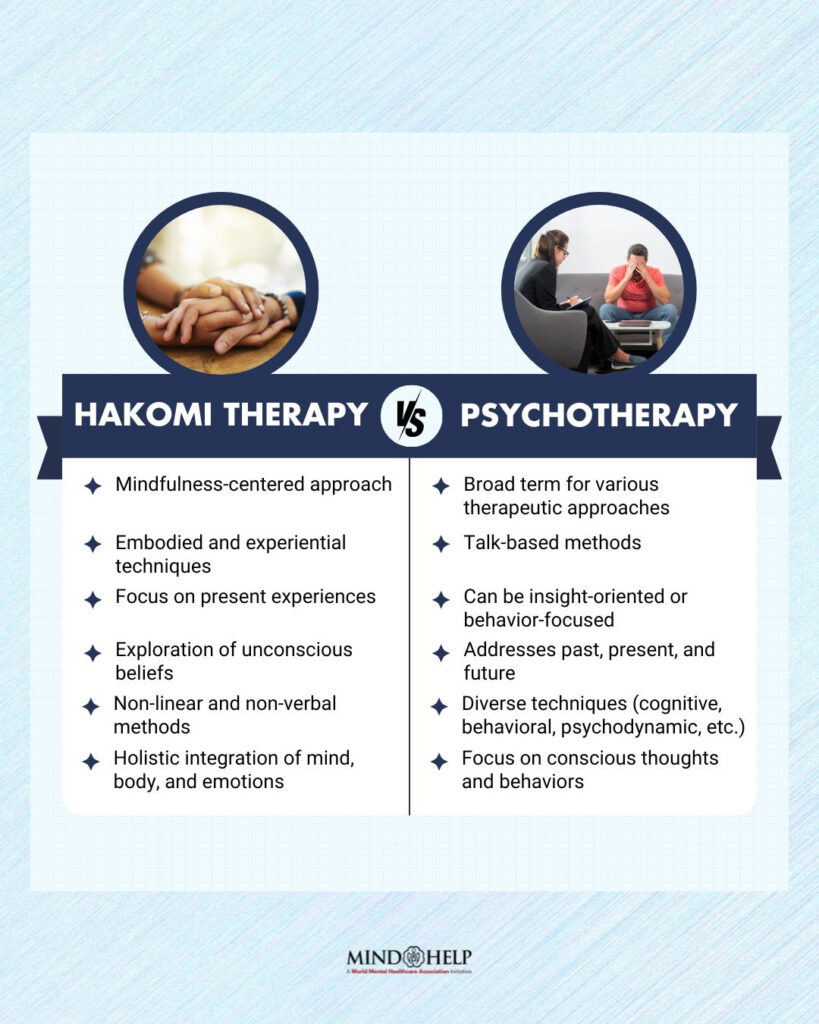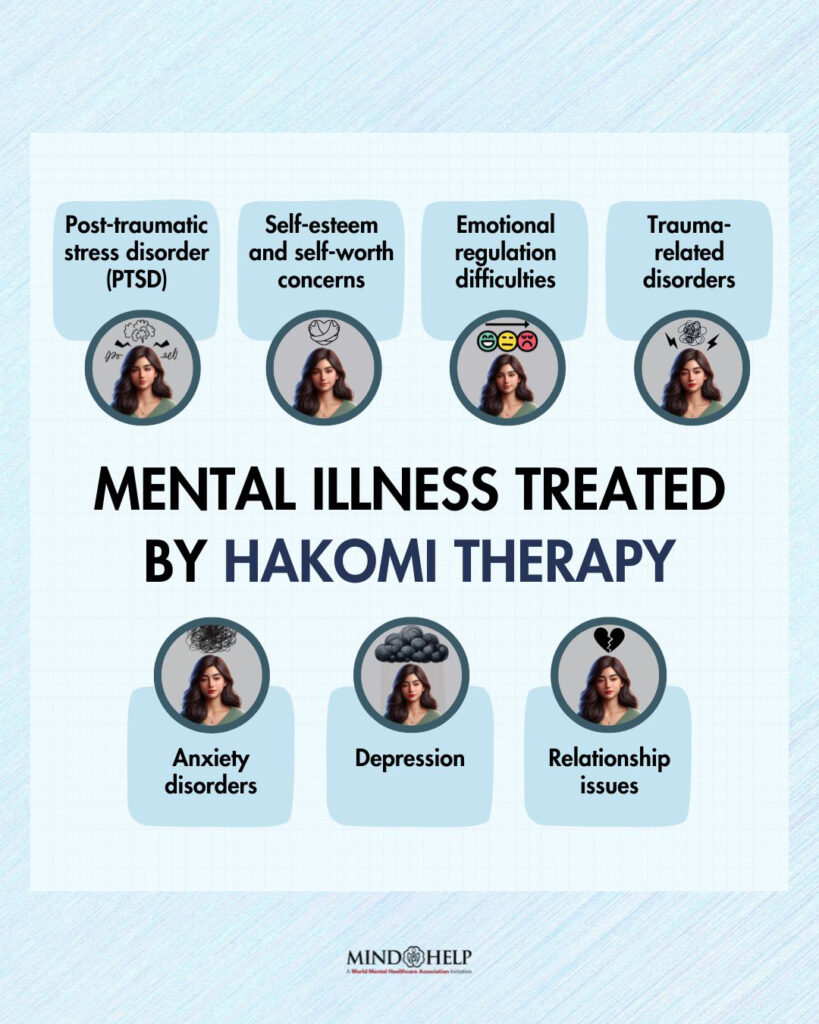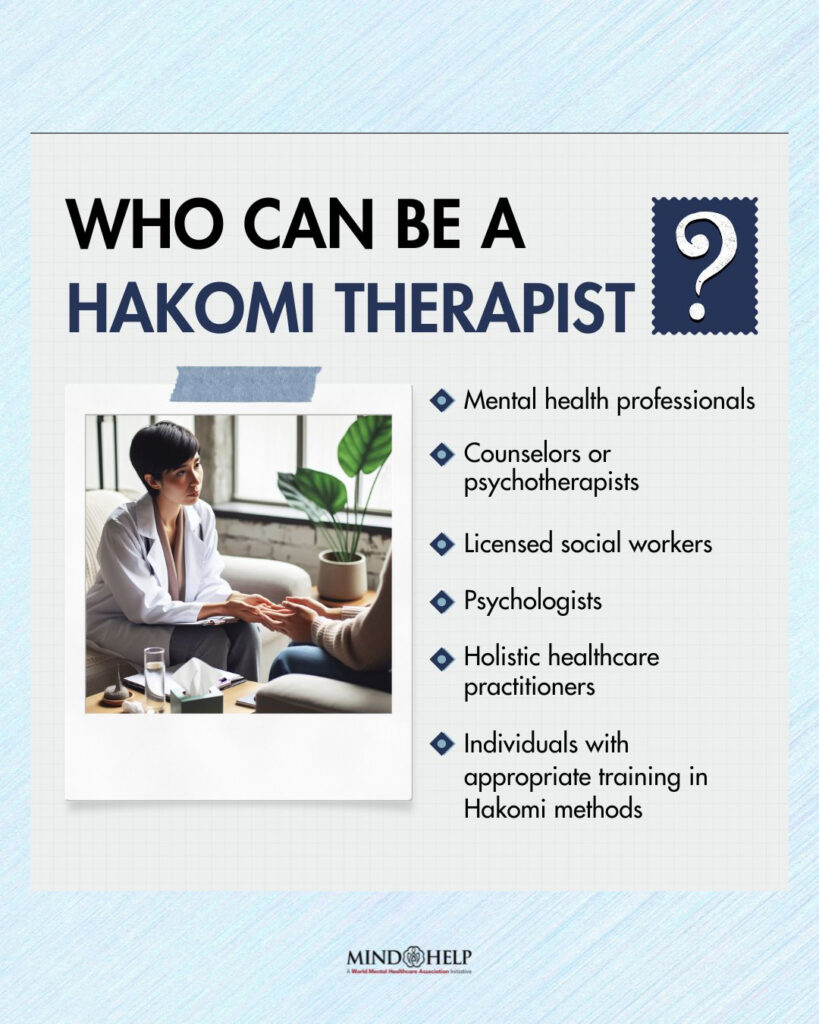Table of Contents
Hakomi therapy is a form of psychotherapy that promotes healing and growth through the integration of mind, body, and emotions. This approach can be applied in various settings to address a wide range of issues such as anxiety, depression, trauma, relationship problems, and personal growth.
What Is Hakomi Therapy?
Hakomi Therapy is a form of body-centered 1 Quinn J. (1996). Janet Quinn, RN, PhD. Therapeutic touch and a healing way. Interview by Bonnie Horrigan. Alternative therapies in health and medicine, 2(4), 69–75. psychotherapy that uses mindfulness to emphasize the exploration of unconscious patterns and beliefs through the therapist and client working together to access and investigate bodily sensations, emotions, and thoughts. It uses a non-invasive and gentle approach that can be effective in addressing the impacts of trauma on the mind and body.
The term “Hakomi” was coined by Ron Kurtz 2 Johanson, G. J. (2009). Psychotherapy, Science, and Spirit: Nonlinear Systems, Hakomi Therapy, and the Tao. Journal of Spirituality in Mental Health, 11(3), 172–212. https://doi.org/10.1080/19349630903081093 , and comes from the Hopi Indian language, which means “Who are you?” or “How do you stand in relation to these many realms?”. During Hakomi therapy, the therapist supports the client’s exploration with compassion and curiosity, while maintaining a sense of safety and containment.
The therapist may also use somatic techniques 3 Kuhfuß, M., Maldei, T., Hetmanek, A., & Baumann, N. (2021). Somatic experiencing – effectiveness and key factors of a body-oriented trauma therapy: a scoping literature review. European journal of psychotraumatology, 12(1), 1929023. https://doi.org/10.1080/20008198.2021.1929023 such as gentle touch, breathing, or body movements to help the client connect in processing their experiences.
History of Hakomi Therapy
Hakomi Therapy emerged in the 1970s, developed by Ron Kurtz 4 Bageant, R. (2011). The Hakomi Method. Journal of Humanistic Psychology, 52(2), 178–189. https://doi.org/10.1177/0022167811423313 , who was a psychotherapist and trainer in Gestalt therapy. Kurtz’s work was informed by his deep engagement with Eastern spirituality 5 Chan, C. L., Ng, S. M., Ho, R. T., & Chow, A. Y. (2006). East meets West: applying Eastern spirituality in clinical practice. Journal of clinical nursing, 15(7), 822–832. https://doi.org/10.1111/j.1365-2702.2006.01649.x , including Buddhism and Taoism, as well as a range of body-centered psychotherapies 6 Tarsha, M. S., Park, S., & Tortora, S. (2020). Body-Centered Interventions for Psychopathological Conditions: A Review. Frontiers in psychology, 10, 2907. https://doi.org/10.3389/fpsyg.2019.02907 of mindfulness, and psychomotor therapy.
Kurtz initially trained a small group of therapists in the Hakomi approach, and over time, the therapy gained popularity among psychotherapists and clients.
He believed that conventional talk therapy did not fully address the complexity of human experience and that deeper levels of healing required an experiential approach that integrates body, mind, and emotions.
Read More About Psychotherapy Here

Core Principles Of Hakomi Therapy
Hakomi Therapy is guided by five core principles 7 Günther, U., Johanson, G., & Kurtz, R. (2006). Hakomi: Strengths & Limitations: Indications and Contraindications for the Use of Hakomi with Clients with Significant Clinical Disturbances. Available from: https://hakomiinstitute.com/Forum/Issue16-17/4_HugoTransUta.pdf , including:
1. Mindfulness
The therapist and client work together to bring present-moment awareness to the client’s experience. Through mindfulness 8 Crego, A., Yela, J. R., Gómez-Martínez, M. Á., Riesco-Matías, P., & Petisco-Rodríguez, C. (2021). Relationships between Mindfulness, Purpose in Life, Happiness, Anxiety, and Depression: Testing a Mediation Model in a Sample of Women. International journal of environmental research and public health, 18(3), 925. https://doi.org/10.3390/ijerph18030925 , the client can access and explore unconscious patterns and beliefs that may be helping in their growth and well-being.
Read More About Mindfulness Here
2. Organicity
Organicity refers to the idea that change happens naturally and spontaneously 9 Abbo C. (2011). Profiles and outcome of traditional healing practices for severe mental illnesses in two districts of Eastern Uganda. Global health action, 4, 10.3402/gha.v4i0.7117. https://doi.org/10.3402/gha.v4i0.7117 when the conditions are right. In Hakomi Therapy, the therapist aims to create the conditions for change by supporting the client’s present-moment awareness and helping them connect with their inner wisdom.
3. Nonviolence
The therapist aims to create a safe and supportive environment for the client which emphasizes cooperation and respect between the therapist and the individual. The therapist works with compassion and curiosity, rather than judgment or criticism 10 Gittins, C. B., & Hunt, C. (2020). Self-criticism and self-esteem in early adolescence: Do they predict depression?. PloS one, 15(12), e0244182. https://doi.org/10.1371/journal.pone.0244182 , to help the client move towards greater healing and growth.
4. Mind-Body Connection
The mind and body are seen as interconnected 11 Renoir, T., Hasebe, K., & Gray, L. (2013). Mind and body: how the health of the body impacts on neuropsychiatry. Frontiers in pharmacology, 4, 158. https://doi.org/10.3389/fphar.2013.00158 in Hakomi Therapy. The therapist helps the client connect with their bodily sensations, emotions, and thoughts to access unconscious patterns and beliefs.
5. Unity
Unity refers to the idea that everything is interconnected and interdependent. In Hakomi therapy, the therapist and client work together to explore the client’s inner world 12 Emery P. E. (1996). The inner world in the outer world: the phenomenology of posttraumatic stress disorder from a psychoanalytic perspective. The Journal of the American Academy of Psychoanalysis, 24(2), 273–291. https://doi.org/10.1521/jaap.1.1996.24.2.273 and their relationship with the world around them. By exploring these connections, the client can gain greater insight and healing.
How Does Hakomi Therapy Work?
Every Hakomi-trained practitioner should follow four techniques 13 Caldwell, C. (2016). Hakomi mindfulness-centered somatic psychotherapy: a comprehensive guide to theory and practice. Body, Movement and Dance in Psychotherapy, 12(1), 70–72. https://doi.org/10.1080/17432979.2016.1166156 , which involve:
1. Contact
Creating a safe and comfortable 14 D’Lima, D., Crawford, M. J., Darzi, A., & Archer, S. (2017). Patient safety and quality of care in mental health: a world of its own?. BJPsych bulletin, 41(5), 241–243. https://doi.org/10.1192/pb.bp.116.055327 environment for the client to participate in therapy.
2. Accessing
The therapist facilitates mindfulness 15 Wielgosz, J., Goldberg, S. B., Kral, T. R. A., Dunne, J. D., & Davidson, R. J. (2019). Mindfulness Meditation and Psychopathology. Annual review of clinical psychology, 15, 285–316. https://doi.org/10.1146/annurev-clinpsy-021815-093423 to help clients become aware of their unconscious beliefs, emotions, and sensations. This involves guiding the client to focus on their present-moment experience and observe any arising thoughts, feelings, or bodily sensations.
3. Processing
During the processing phase, the therapist explores the client’s experiences and responses and helps to create new experiences. Somatic experiencing is used to delve deeper into the client’s sensations and images, allowing the client to explore their internal experiences and gain a deeper understanding of their emotions and beliefs 16 Barrett, L. F., Mesquita, B., Ochsner, K. N., & Gross, J. J. (2007). The experience of emotion. Annual review of psychology, 58, 373–403. https://doi.org/10.1146/annurev.psych.58.110405.085709 .
4. Integration
Integration is the final phase, where the therapist helps the client apply the insights gained in therapy to their activities of daily life. This may include offering practical suggestions, identifying negative patterns of thoughts, and supporting personal growth. By integrating what they learned, clients can continue to improve their well-being 17 Cloninger C. R. (2006). The science of well-being: an integrated approach to mental health and its disorders. World psychiatry : official journal of the World Psychiatric Association (WPA), 5(2), 71–76. .

Effectiveness Of Hakomi Therapy On Mental Health Functioning
Research suggests that Hakomi Therapy can be effective in promoting well-being 18 Kelly, S., & Papps, F.A. (2019). ‘The Wisdom Lies Within’: Investigating Therapeutic Presence From A Hakomi Therapy Perspective. Available from: https://www.researchgate.net/publication/338500599_’The_Wisdom_Lies_Within’_Investigating_Therapeutic_Presence_From_A_Hakomi_Therapy_Perspective and adequate mental health functioning. Some of the beneficial ways of Hakomi therapy include:
- Hakomi therapy can reduce the symptoms of anxiety and depression 19 Tarsha, M. S., Park, S., & Tortora, S. (2020). Body-Centered Interventions for Psychopathological Conditions: A Review. Frontiers in psychology, 10, 2907. https://doi.org/10.3389/fpsyg.2019.02907 , as well as improvements in overall psychological functioning.
- Hakomi therapy emphasizes mindfulness 20 Keng, S. L., Smoski, M. J., & Robins, C. J. (2011). Effects of mindfulness on psychological health: a review of empirical studies. Clinical psychology review, 31(6), 1041–1056. https://doi.org/10.1016/j.cpr.2011.04.006 and body awareness, which can be helpful for individuals with post-traumatic stress disorder 21 Mann, S. K., & Marwaha, R. (2022, February 7). Posttraumatic Stress Disorder (PTSD). PubMed; StatPearls Publishing. Available from: https://www.ncbi.nlm.nih.gov/books/NBK559129/ (PTSD), to access and process their traumatic experiences.
- Hakomi therapy can be beneficial to increase resilience and coping skills 22 Macía, P., Barranco, M., Gorbeña, S., Álvarez-Fuentes, E., & Iraurgi, I. (2021). Resilience and coping strategies in relation to mental health outcomes in people with cancer. PloS one, 16(5), e0252075. https://doi.org/10.1371/journal.pone.0252075 by helping individuals develop a deeper understanding of themselves, making them better equipped to manage life’s challenges.
- Hakomi therapy can help individuals become more aware of their bodily sensations and emotional experiences, which can lead to improved sleep quality 23 Shallcross, A. J., & Visvanathan, P. D. (2016). Mindfulness-Based Cognitive Therapy for Insomnia. Mindfulness-Based Cognitive Therapy, 19–29. https://doi.org/10.1007/978-3-319-29866-5_3 and reduced insomnia over time.

Benefits of Hakomi Therapy
Hakomi therapy can offer a wide range of benefits 24 Tarsha, M. S., Park, S., & Tortora, S. (2020). Body-Centered Interventions for Psychopathological Conditions: A Review. Frontiers in psychology, 10, 2907. https://doi.org/10.3389/fpsyg.2019.02907 for overall wellness and health, as well as quality of life management, which are:
1. Increased Self-awareness
Hakomi therapy focuses on exploring the body and physical sensations to gain insight into emotions, thoughts, and behavior patterns. This can lead to greater self-awareness 25 Sutton A. (2016). Measuring the Effects of Self-Awareness: Construction of the Self-Awareness Outcomes Questionnaire. Europe’s journal of psychology, 12(4), 645–658. https://doi.org/10.5964/ejop.v12i4.1178 and understanding of oneself.
2. Increased Self-compassion
The gentle and non-judgmental approach of Hakomi therapy can help individuals 26 Su, H., Wang, L., Li, Y., Yu, H., & Zhang, J. (2019). The mediating and moderating roles of self-acceptance and self-reported health in the relationship between self-worth and subjective well-being among elderly Chinese rural empty-nester: An observational study. Medicine, 98(28), e16149. https://doi.org/10.1097/MD.0000000000016149 develop greater self-acceptance.
3. Enhanced Physical Well-being
Hakomi therapy’s emphasis on the mind-body connection can help patients improve physical symptoms related to stress, such as headaches and muscle tension.
4. Improved Relationships
By developing a deeper understanding of oneself 27 Leitan, N. D., & Murray, G. (2014). The mind-body relationship in psychotherapy: grounded cognition as an explanatory framework. Frontiers in psychology, 5, 472. https://doi.org/10.3389/fpsyg.2014.00472 and learning to regulate emotions, individuals can improve their relationships with others and cultivate healthier connections.
Limitations of Hakomi Therapy
Although Hakomi therapy can be advantageous 28 Wahbeh, H., Elsas, S. M., & Oken, B. S. (2008). Mind-body interventions: applications in neurology. Neurology, 70(24), 2321–2328. https://doi.org/10.1212/01.wnl.0000314667.16386.5e for some, it has a few limitations to consider:
- The availability 29 Carletto, S., Borghi, M., Francone, D., Scavelli, F., Bertino, G., Cavallo, M., Malucchi, S., Bertolotto, A., Oliva, F., & Ostacoli, L. (2016). The efficacy of a Mindfulness Based Intervention for depressive symptoms in patients with Multiple Sclerosis and their caregivers: study protocol for a randomized controlled clinical trial. BMC neurology, 16, 7. https://doi.org/10.1186/s12883-016-0528-0 of Hakomi therapy may be limited in some parts of the world, which can make it inaccessible to some people.
- Additionally, it may not be the best fit for those with severe mental health issues that require more intensive treatment, such as hospitalization 30 Velelekou, A., Papathanasiou, I. V., Alikari, V., Papagiannis, D., Tsaras, K., & Fradelos, E. C. (2022). Factors influencing the duration of hospitalization of patients with schizophrenia. Medicine and pharmacy reports, 95(3), 290–299. https://doi.org/10.15386/mpr-2144 or medication management.
- Lastly, people with traumatic or abusive experiences 31 Substance Abuse and Mental Health Services Administration. (2014). Understanding the impact of trauma. Nih.gov; Substance Abuse and Mental Health Services Administration (US). Available from: https://www.ncbi.nlm.nih.gov/books/NBK207191/ related to their body or physical sensations, or who may feel uncomfortable exploring emotions may be triggered by Hakomi therapy which emphasizes body awareness and physical sensations.
Takeaway
Hakomi therapy is a unique and effective approach to psychotherapy that recognizes the interconnectedness of mind, body, and emotions. By using mindfulness, somatic experiences, and the principles of nonviolence, unity, and organicity, Hakomi therapists can create a safe and supportive environment for clients to explore their inner world and achieve deep healing and transformation.
At A Glance
- Hakomi Therapy is a body-centered, mindfulness-based approach to psychotherapy that emphasizes the interconnectedness of mind, body, and emotions.
- The connection between Hakomi therapy and trauma survivors is beneficial, as it provides a safe and non-judgmental space to heal from past experiences.
- Key guiding principles in Hakomi therapy are mindfulness, organicity, nonviolence, mind-body connection, and unity.
- The 4 techniques of Hakomi therapy include contact, accessing, processing, and integration.
- Hakomi therapy reduces symptoms of anxiety and depression, processing and healing from trauma, and improves overall well-being.
- Hakomi Therapy has limitations, as it may not be suitable for individuals with severe mental health conditions.
Frequently Asked Questions (FAQs)
1. What are the five principles of Hakomi?
The five principles of Hakomi are mindfulness, nonviolence, unity, organicity, and mind-body holism, which guide the therapeutic process toward creating a safe and supportive environment for the client to explore their inner world.
2. Does Hakomi therapy work?
Research suggests that Hakomi therapy is an effective approach to treating a range of mental health concerns, with clients reporting significant improvements in symptoms and overall well-being.
3. How to find a good Hakomi therapist?
To find a good Hakomi therapist, it’s important to research licensed therapists with training and experience in Hakomi, ask for referrals, and read reviews from previous clients.











